Quick search
CTRL+K
Quick search
CTRL+K

Stuttgart is the capital of the German state of Baden-Württemberg, and the city has a great location between soft hills, vineyards and hot springs. There are a lot of sights here, as well as recreational facilities. It is never far to lovely nature in the city center and in the immediate vicinity.
As a residential city, Stuttgart has its share of impressive and elegant castles and residences, from the old Alte Schloß to the elegant Neue Schloß from the Baroque era. You can also walk the vast historic castle gardens extending from the city center, and arrive at king Wilhelm I’s Moorish-inspired buildings in the oasis of Wilhelma.
As a big city, there are many museums, churches and other institutional buildings in Stuttgart from the times as a royal city to present day modern state capital. The main street Königstraße is also a must for a stroll, and you find some of the city’s famous sights along the street. You can also enjoy yourself year round in the warm thermal water springs, which is accessible at several spas and public pools around the Neckar river.
Stuttgart is also one of the technological strongholds in Germany and Europe. Names like Bosch, Mercedes-Benz and Porsche all come from here, and a visit to the two carmaker’s museums is something for anyone who wants to be impressed. Different technologies can be enjoyed at the city tram museum, which has a lot of equipment in the large exhibition hall.
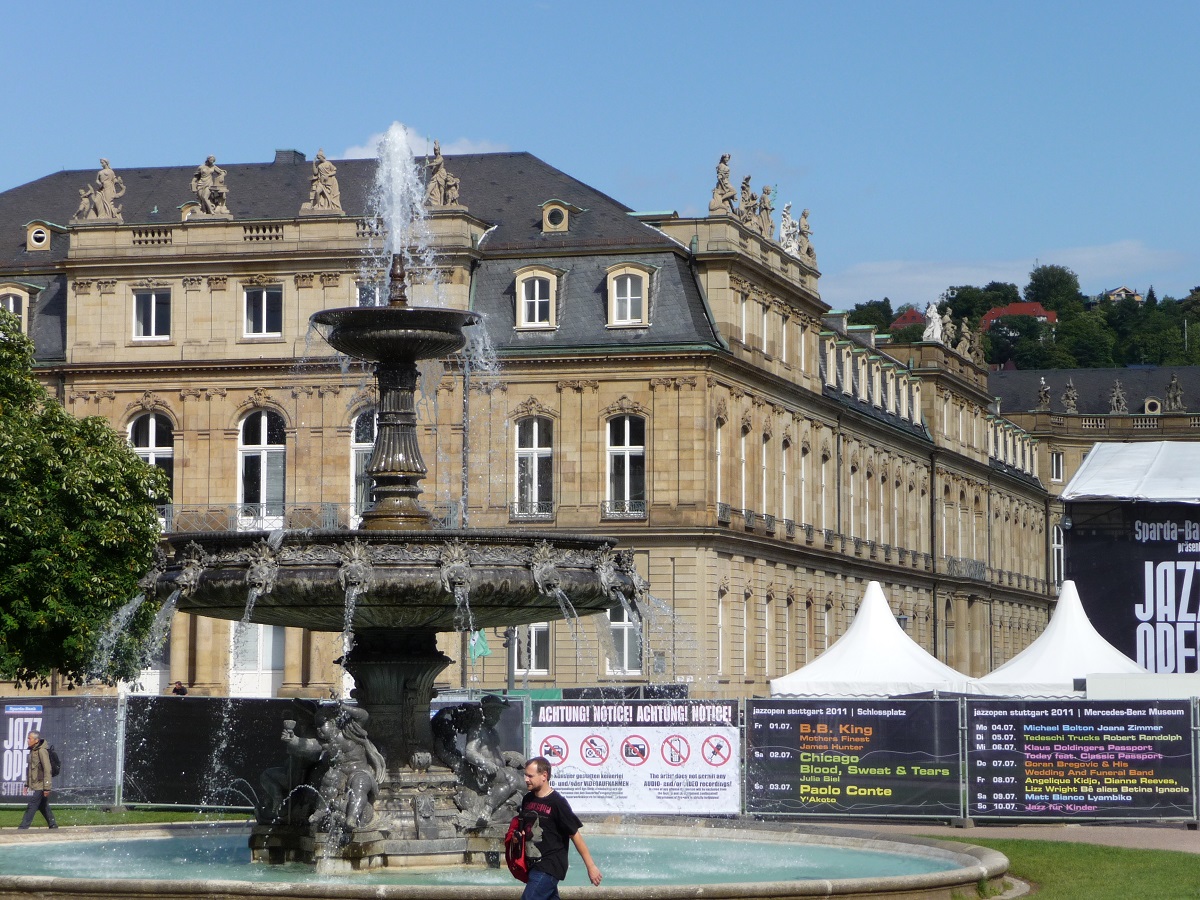
Schloßplatz is the large, central square in Stuttgart, and the city’s main thoroughfare, Königstraße, crosses the northwest part of the square. Schloßplatz is also the setting for several of the city’s magnificent buildings, with the Dukes’ former residence castle, the Neue Schloß, as the highlight.
The square itself is laid out as a baroque park with a fountain and music pavilion. In the middle is the 30-metre-high Jubilæumssäule/Jubiläumssäule from 1841. The pillar was erected on the occasion of King Wilhelm I’s 25th jubilee.
Around the base of the column are reliefs that mainly illustrate victories during the Napoleonic Wars. The column is crowned by a statue of the Roman goddess Concordia, who symbolizes unity, understanding and marital harmony.
Traditionally, Württemberg’s regents lived at the Old Castle/Alte Schloß. Over time, the castle-like residence had been covered over, and Duke Carl Eugen had Det Nye Slot/Neue Schloß built as a sumptuous baroque complex. Carl Eugen’s inspiration was French Versailles.
The foundation stone was laid in 1746, and the architect from the beginning was Leopoldo Matteo Retti. He was the nephew of Donato Giovanni Frisoni, who was behind the castle in nearby Ludwigsburg. The Neue Schloß is built as a three-wing facility with the main wing centrally located, which was a typical layout of the time.
In the early 1760s, the castle was not completed, and when Carl Eugen moved to Ludwigsburg in 1764, work came to a standstill for about ten years. The duke returned to Stuttgart in 1775, and the following years saw the fitting out of several parts of the facility.
At the beginning of the 19th century, Württemberg’s King Friedrich II had part of the Neue Schloß decorated in the imperial style, and the place remained a residence until the middle of the century. Today, large parts of the castle are used as representation rooms and offices for ministries in the state of Baden-Württemberg. The state’s Landesmuseum also has part of its collections and exhibitions here; e.g. The Roman Lapidarium/Römisches Lapidarium in the vaults under the castle.
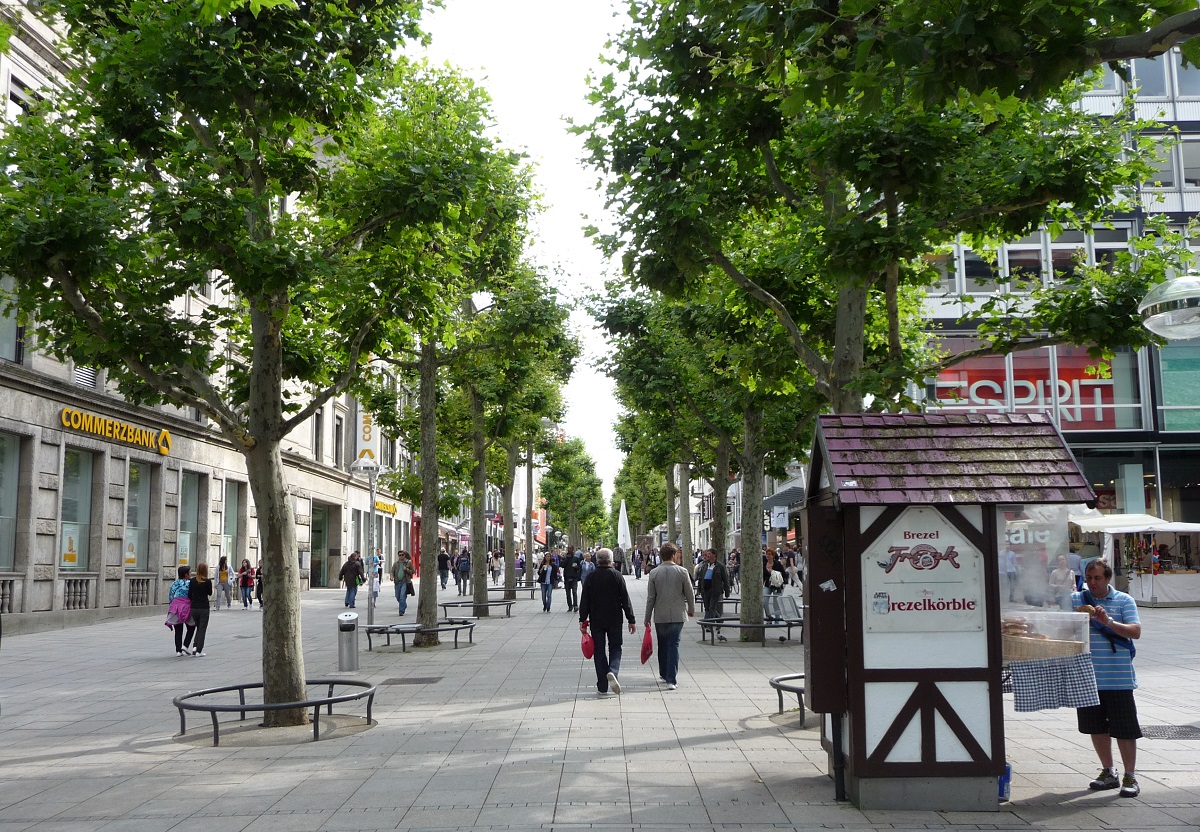
The street Königstraße is Stuttgart’s 1.2 kilometer long street. It stretches from the main railway station in the north-west through the entire city center to the south-west. Shops and warehouses lie like pearls on a string under the beautiful tree crowns, which form a lovely and airy urban space.
Among the street’s dominant buildings are the area around Castle Square/Schloßplatz, St Eberhard Cathedral/Domkirche Sankt Eberhard (Königstraße 7) and Mittnachtbau (Königstraße 46).
The Staatsgalerie is an art museum that has grown considerably since its opening in 1843 and is today considered one of Germany’s leading museums of its kind. There are two parts; The Old State Gallery/Alte Staatsgalerie and the New State Gallery/Neue Staatsgalerie.
The classicist building that forms the Alte Staatsgalerie was built in 1843 and extended 1881-1887. Originally, there was also an art academy here. Now it houses collections of old German paintings dating back to the 14th century, Italian and Dutch works from 16th-18th century paintings as well as 19th-20th century art from Romanticism and Impressionism.
The Neue Staatsgalerie opened in 1984 next to the Alte Staatsgalerie. Here you can see collections from the 1900s to the present day. Artists such as Joan Miró and Pablo Picasso are represented.
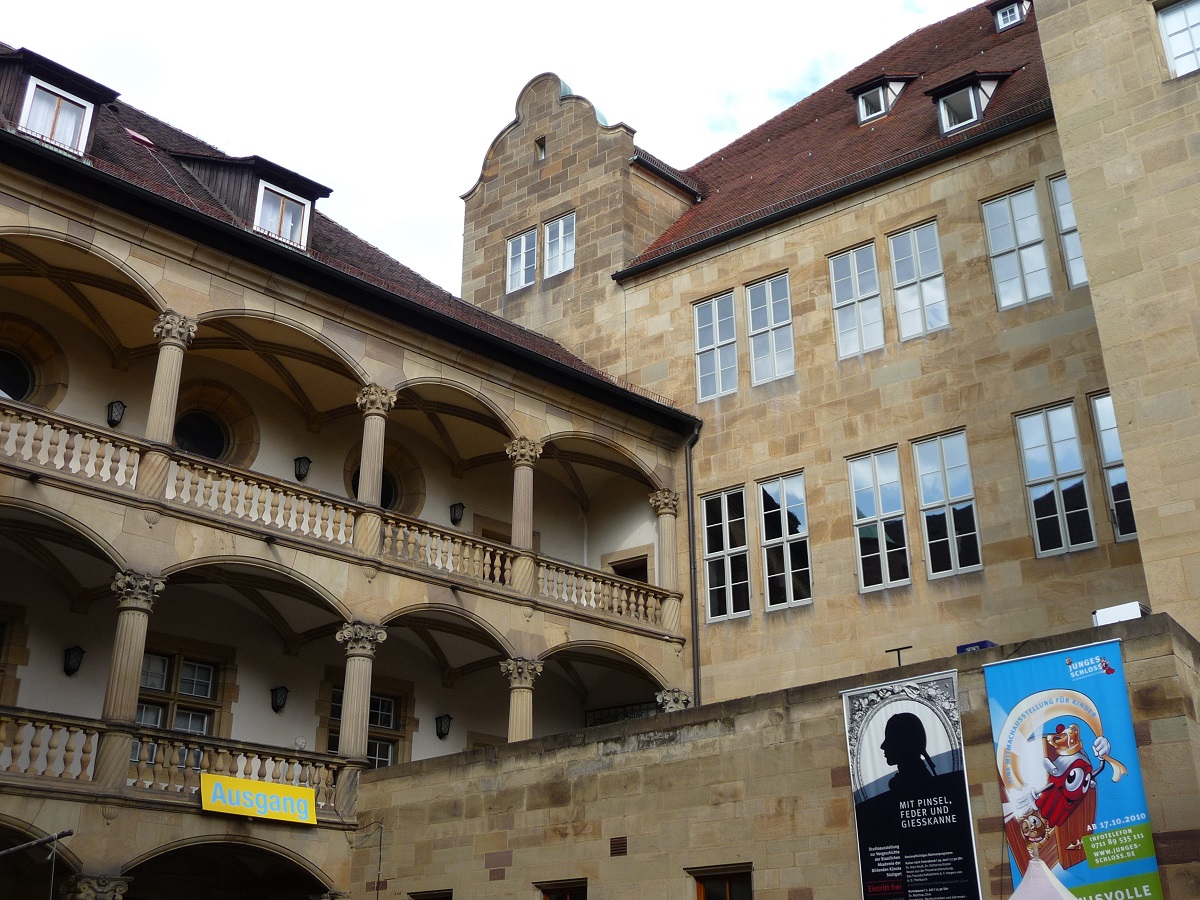
Alte Schloß’s history goes back to the first construction around the year 950. Back then it was a traditional castle, which was built with moats around it, so that the place could be more easily defended. In the 14th century, the castle became the residence of Württemberg’s counts, and the economy was also managed from here through the Hofkammer.
In the period 1553-1578, the dukes had the castle rebuilt into a Renaissance castle, and a castle church was built, among other things. In the 18th century, the moats were looped.
The Protestant Castle Church/Schloßkirche was decorated 1558-1562 by Aberlin Tretsch. Especially the interior with arches and the fine ceiling are worth seeing. In 1806, the interior was changed, and a crypt was built under the church, where, among others, King Karl I and Queen Olga are buried.
In the castle courtyard stands an equestrian statue of Eberhard I, who in 1495 became Württemberg’s first duke and who made Stuttgart the residence of the court. The courtyard’s arcade design is inspired by Italian architectural style, and there should have been arcades all around the square.
Today, the Landesmuseum Württemberg occupies large parts of the Alte Schloß. The museum was founded by King Wilhelm I in 1862. The purpose of the museum is to present the history of Württemberg. However, other collections are also exhibited here; e.g. objects from antiquity in the Mediterranean area. However, the art and cultural history of Württemberg itself is the core of the museum. One of the distinguished objects is the Württemberg crown.
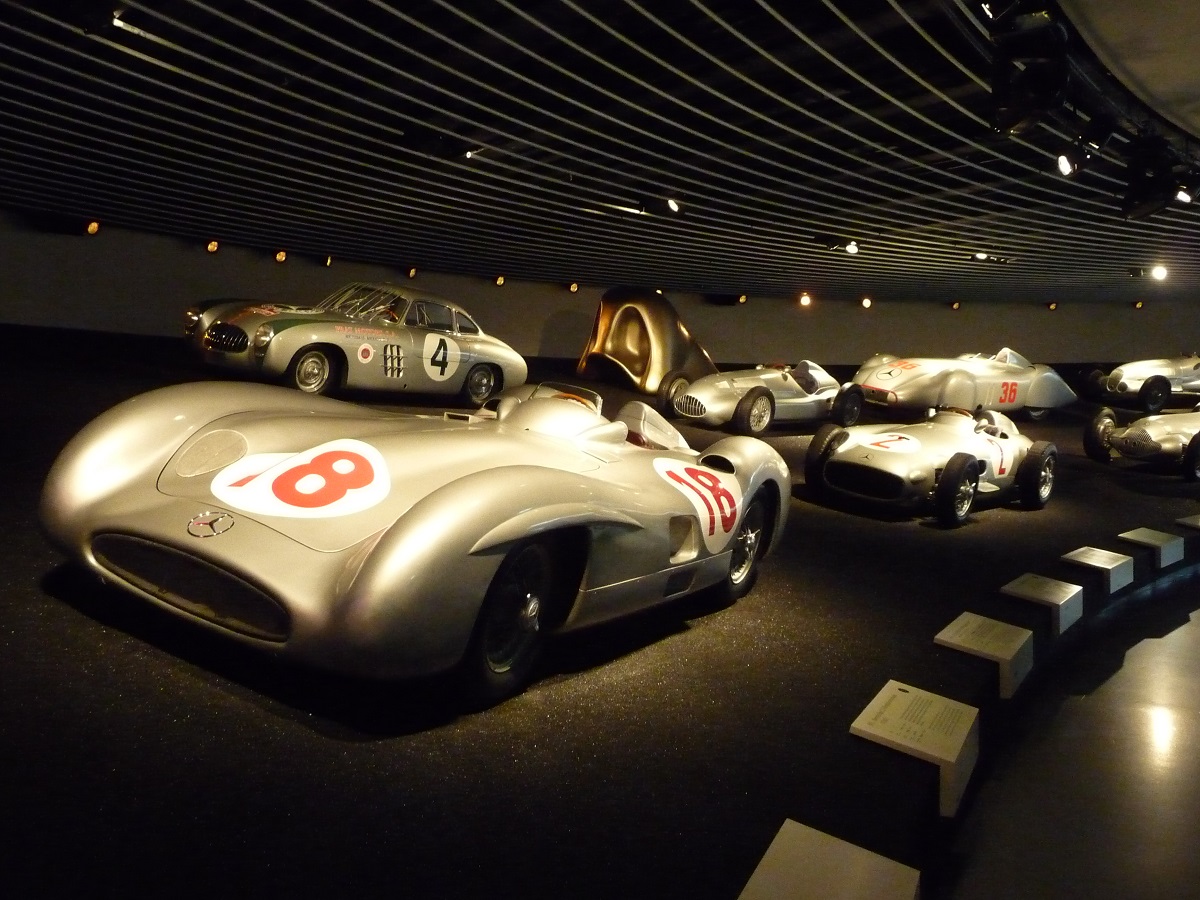
Almost regardless of whether you are interested in cars or not, the Mercedes-Benz Museum is worth a visit. The exciting museum building takes visitors by elevator to the top, before a chronological journey through both world history and the history of the company begins. Various aspects of the development of technology since the 19th century are reviewed, and engineering and cars are seen in relation to major events on the globe.
Throughout time there are polished cars from Mercedes-Benz brands throughout time, and there are many special themes; eg trucks, buses and the history of racing cars. And here is something for everyone; the gull wing, the silver arrows, the luxury of the 1930s, the WC bus from 1974 and much more.

This theater is the Stuttgart Opera House. It was built 1909-1912 as the Royal Court Theater/Königliche Hoftheater with two buildings; The Big House/Großes Haus and the Little House/Kleines Haus.
The Großes Haus, with its beautiful location next to Lake Eckensee, is the landmark of theaters, and it stands in its original appearance. The Kleines Haus was built in a new style after the Second World War and opened in 1962. Today, both ballet, opera and plays are performed in the theater.
In the district of Killesberg is the park Höhenpark Killesberg, which is a nice, recreational area close to the city centre. The park was laid out in connection with the 1939 Reichsgartenschau garden exhibition, which opened with pomp and pageantry and attracted around 4.5 million visitors in four months.
For the exhibition in 1939, a railway over two kilometers long was built in the park; Killesbergbahn. The gauge is 381 millimetres, and during the season it is run with both steam and diesel. The covered wagons are in contrast to the locomotives from the opening of the line and constructed at Görlitzer Waggonbau 1937-1938.
The park’s lawns, many fountains, open-air baths and various works of art invite you to activities and good walks, and if you want to see it all from above, you can go up the 42-metre-high Killesberg tower/Killesbergturm. The tower was built in 2001 and consists of four platforms connected by spiral staircases. The light and open construction means that there are good views all the way up.
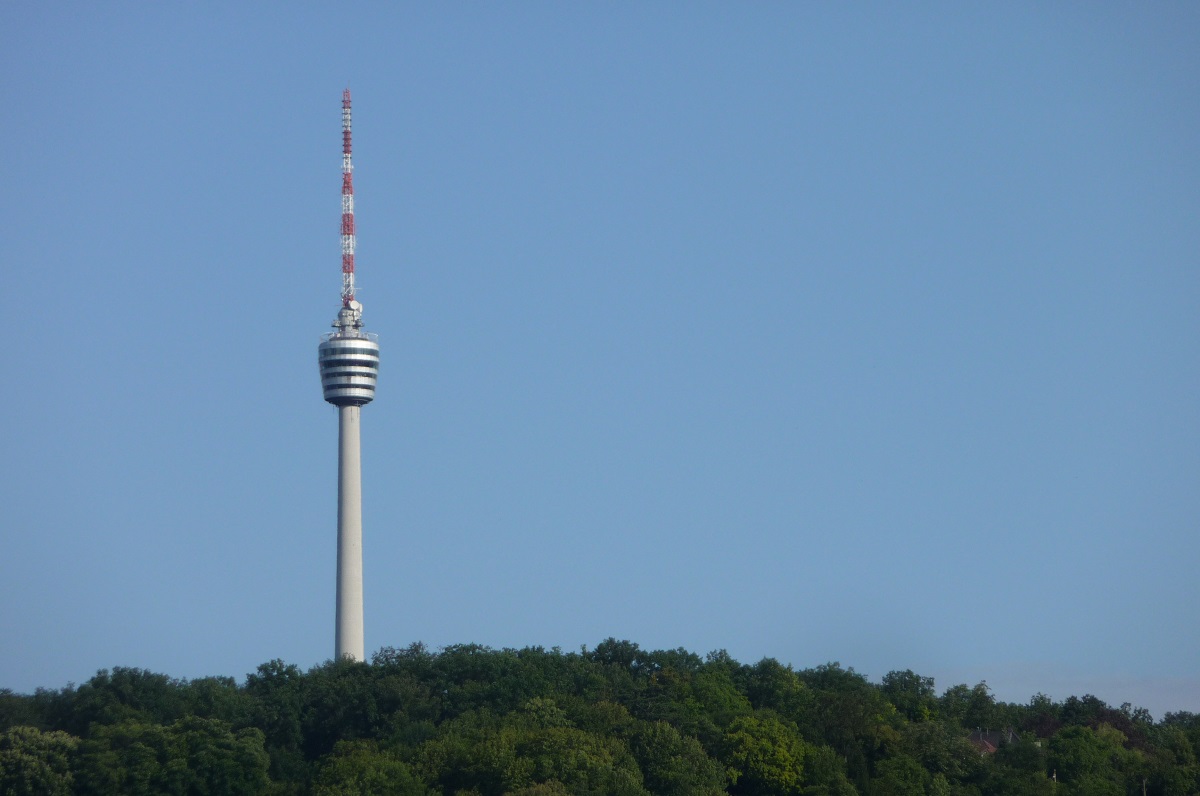
The Fernsehturm towers over Stuttgart with its height of 216.61 meters on the Bopser mountain. The tower was built at a level of 485 meters above sea level, and between 147 and 152.40 meters up there is a café and two observation decks. From here there is a formidable view, where you can really see that the city lies beautifully in a valley with forests and vineyards around it.
The tower was built in 1954-1955 in reinforced concrete and is the first of its kind in the world. It was inaugurated on 5 February 1956, and since then television towers have been built in many places around the world according to the same template. In Stuttgart, it was the company Südwestrundfunk (SWR) that had the tower built to transmit radio programs to the Stuttgart area.
Königsbau was built in the middle of 1856-1860 in classicist style. Königsbau is dominated by a 135 meter long colonnade with 34 columns. It is today one of the most striking buildings on the main street Königstraße, and today you can find the shopping center Königsbau Passagen behind the columns.
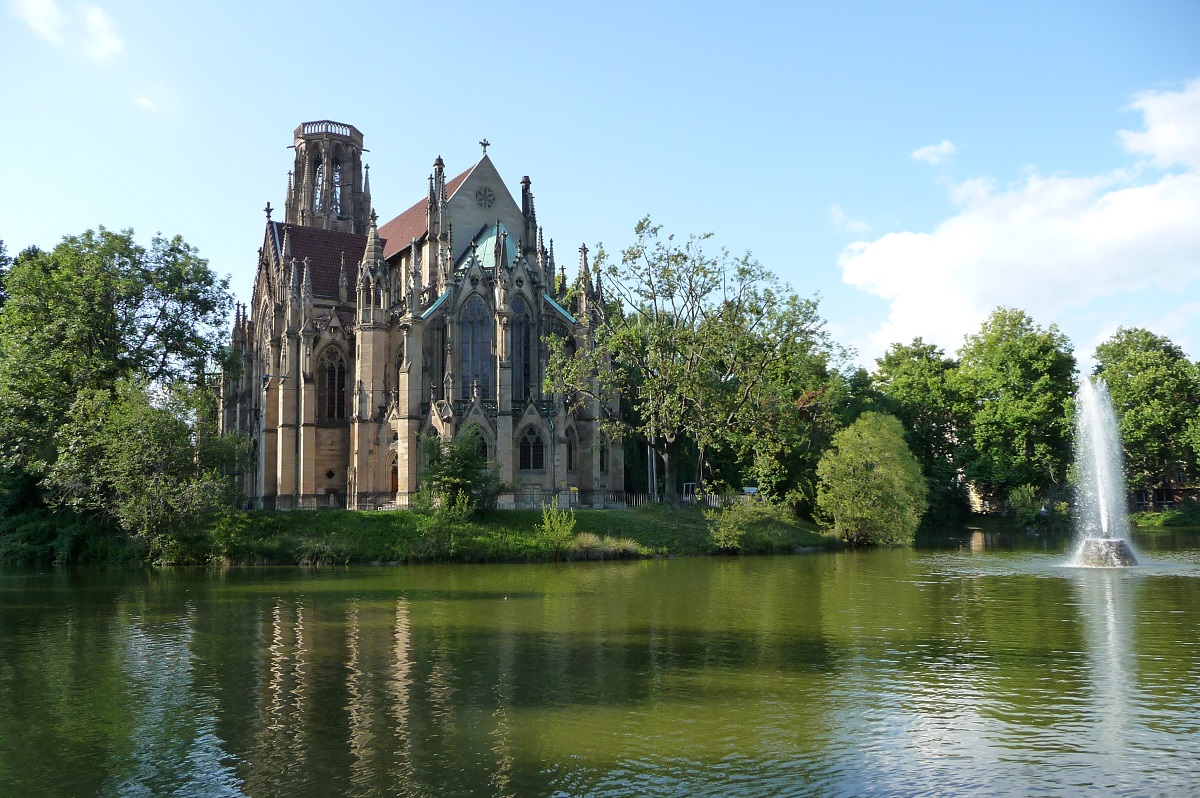
Johanneskirche was built 1864-1876 in neo-Gothic style. Construction was initiated due to a lack of capacity for the city’s Protestant congregation, which in the mid-1800s numbered around 45,000 people. The church was built with 1,300 seats.
The architect Christian Friedrich Leins built the church on concrete foundations in the lake Feuersee. It is beautifully located by the water, which is surrounded by trees like one of Stuttgart’s little oases. The church also forms the southern starting point of alleen Johannesstraße.
The church originally had a spire on the tower of the now flat top. The spire was not rebuilt after destruction in 1943-1944. Rudolf Yelin made the windows in 1969.
Stuttgart’s cog railway is colloquially called the Zacke, and it connects the district of Heslach and the higher-lying Degerloch. The track was opened in 1884 with cogs following the Riggenbach system; named after the inventor Niklaus Riggenbach.
Along the 2.2 kilometer stretch, the track rises from a height of 266 meters from Marienplatz over 473 meters at Nägelestraße to 470 meters at the terminus in Degerloch. Between Liststraße and Pfaffenweg stations, the increase is 17.8%. Along the way, between Pfaffenweg and Wielandshöhe, there is a fine view of Stuttgart.
A curiosity at the track is the bicycle carriage attached to the train. The cart is a platform for the purpose, where you put the bikes yourself before the trip.
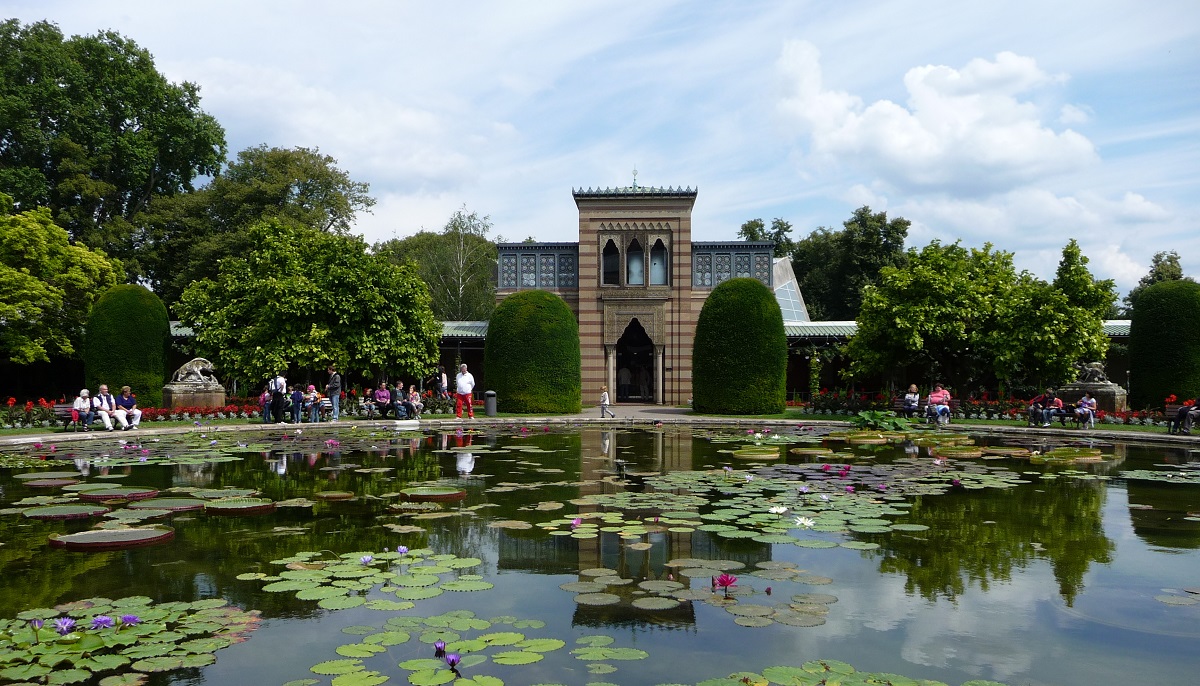
Wilhelma is a combined zoo and botanical garden. Historically, the facility started out as a castle, and with the preserved buildings from this era, it just adds another perspective to a visit to the garden.
Historically, the area belonged to the castle Schloß Rosenstein to the south; today the large Rosensteinpark is also immediately south of Wilhelma. In 1829, mineral water springs were discovered in the area, and King Wilhelm I therefore wanted to build a bathhouse with a surrounding orangery as protection.
The architectural inspiration came from the Moorish buildings of the Spanish Alhambra. Construction began in 1842, and housing, greenhouses and a beautiful park were also built in the complex. In the residence, the castle, there was, among other things, a lavishly decorated ballroom in Moorish style, and the wedding between Crown Prince Karl and the Tsar’s daughter Olga took place here.
Already from 1812 there had been animals here. It was King Friedrich I who thus founded the forerunner to the zoo, which today is home to more than 8,000 animals on a large area that provides plenty of space for both the animals and elegant facilities around them. Among other things, there is a large area with bonobos, chimpanzees, gorillas and orangutans, big cats, bears, savannah animals, aviaries, an aquarium and a large area with a children’s zoo. In many places there are large playgrounds along the way.
Botanically, Wilhelma is also impressive. Here are thousands of different plants, all planted and landscaped very nicely outdoors or in greenhouses. All the world’s climate zones are represented, and among the special examples is a planting with some of California’s giant trees and the giant flower Amorphophallus titanum.
The Mittlerer Schloßgarten is the middle of the three parts of the Schloßgarten, which stretches from the city center to the river Neckar. There are large lawns and the lake Schloßgartensee, and then you can visit the Carl-Zeiss-Planetarium/Carl-Zeiss-Planetarium.
You can also see the Lysthusruinen/Lusthausruine, which is the preserved part of the New Lusthus/Neue Lusthaus, which was built 1584-1593 in the German Renaissance. After a fire in 1902, the ruins remained, where the Kunstbygningen/Kunstgebäude is now located on the Schloßplatz square.
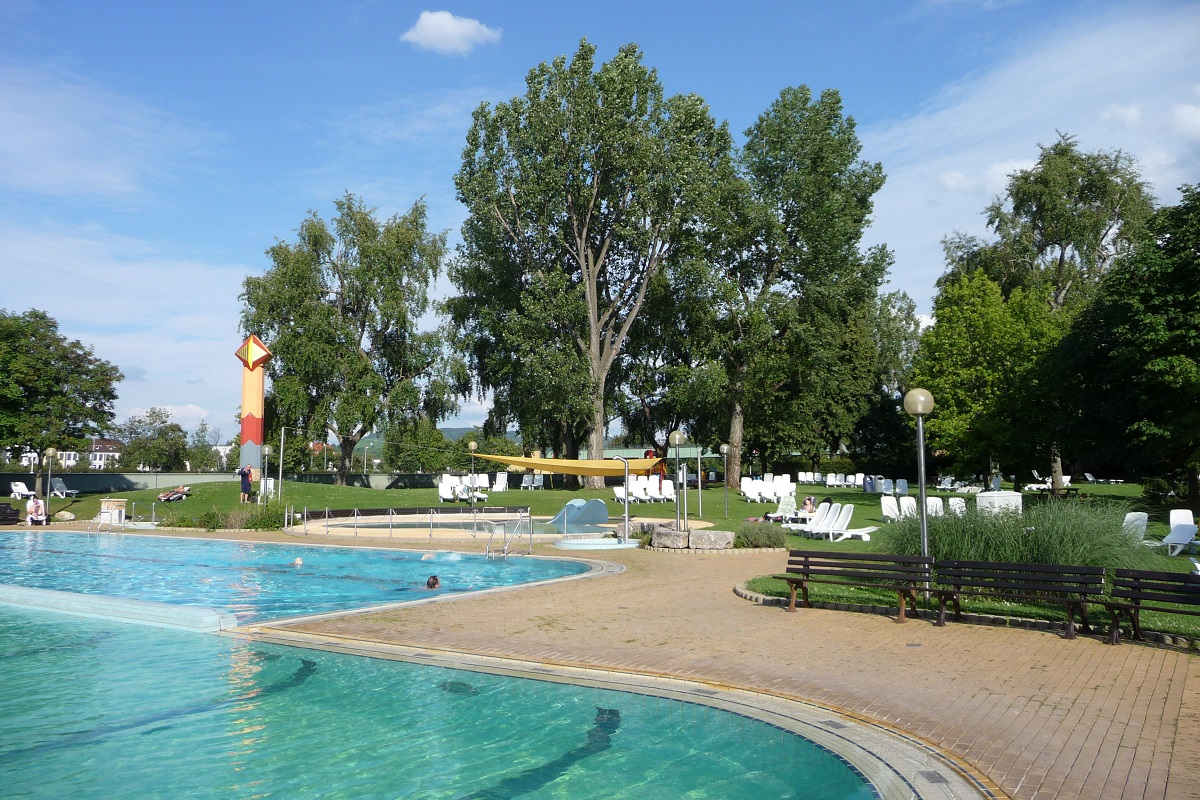
Mineralbad Cannstatt is one of Stuttgart’s bathing facilities that uses the city’s abundant mineral water deposits. The bath has several basins; indoors and outdoors. The water is mineral water from the springs below the area, and the temperature varies from cold baths to a pool with 36 degree warm water. Here the water comes from the source Hofrat-Seyffer-Quelle.
The Bismarckturm is a tower built on the highest point in northern Stuttgart; Gähkopf, which reaches a height of 409 meters. The tower is 20 meters high and it opened in 1904. It was originally built to be able to burn a 3-5 meter high flame on tar and kerosene in honor of the German statesman Otto von Bismarck. Today you can visit the platform at the top of the tower. After the steps you are rewarded with a very nice view.
Ludwigsburg is a city located on the river Neckar north of Stuttgart. The town arose in the early 1700s, when Duke Eberhard Ludwig of Württemberg started the construction of a large baroque castle. Construction began in 1704, and after a few years Eberhard Ludwig expanded the plan for the intended palace to also include the establishment of a city. The settlement was established in 1709, and it received formal status as a town in 1718.
Ludwigsburg is today a favorite excursion destination from Stuttgart, which is not least due to Duke Ludwig’s magnificent palace and the other facilities and buildings he initiated. Residenzschloss Ludwigsburg was built as a magnificent palace modeled after Versailles, and it became the country’s largest palace complex with over 450 rooms and halls and a beautiful and impressive baroque garden in connection with the palace’s main building. The garden lies south of the palace, while to the north you can enjoy a large park.
If you continue north through the park, you will come to the hunting and pleasure castle Favorite. Schloss Favorite was built by Eberhard Ludwig in the years 1717-1723 after designs by Donato Giuseppe Frisoni. The Duke got inspiration for the construction of Favorite from the Gartenpalais in Vienna, Austria. Both Ludwigsburg’s residence castle and Favorite are today open to visitors who can enjoy beautiful interiors. You can also enjoy a walk in the landscaped garden, which stretches to the northwest in the direction of Seeschloss Monrepos, which is Ludwigsburg’s third building in connection with the ducal palace construction. It was Eberhard Ludwig who built the small hunting lodge as the pavilion Seehäuslein in 1714, and it was extended in Baroque style from 1760.
You can of course also go for a walk in the city of Ludwigsburg, and the Marktplatz square is a good place to start. In the middle of the 110×80 meter square stands the Marktbrunnen with a statue of the founder, Duke Eberhard Ludwig. Around the square are fine arcaded houses, and opposite each other stand the Protestant Stadtkirche and the Catholic Kirche zur Heiligsten Dreieinigkeit. From the market square, you can easily walk to the city’s shopping district and to the Ludwigsburg Museum, which tells about the city’s history in an exciting way.
Tübingen is a cozy small town located south of Stuttgart. Its history dates back to the 12th century, and despite Tübingen’s relatively modest size, the city has played an important cultural and political role in the area. Thus, many over the years have studied at Eberhard Karls Universität, which was founded in 1477 by the then Duke Eberhard. The university still plays a large role in the city, where a large percentage of the inhabitants are students.
The old town of Tübingen lies between the rivers Neckar and Ammer. Altstadt is the city’s major attraction as a whole, because the city was not destroyed during World War II. As a result, the old part of Tübingen has been preserved as one of the best examples of an Altstadt in Germany. In the cobbled streets you can see half-timbered houses, cozy squares and buildings such as Tübingen’s town hall and Stiftskirche from the latter half of the 15th century, where several dukes are buried.
South of the old part of Tübingen flows the Neckar, and precisely here two river arms form the island Neckarinsel in a straight stretch. The island is laid out as a park, where you can enjoy a stroll under old plane trees on Platanenallee. From Neckarinsel you can also see the so-called Neckarfront, which consists of a series of brightly colored gabled houses on the northern bank of the Neckar. The Neckarfront is Tübingen’s landmark, and in the row of houses you can see the Hölderlinturm, which was the home of the writer and philosopher Friedrich Hölderlin in the years 1807-1843.
Burg Hohenzollern is a castle that is home to the Hohenzollern family of German princes, kings and emperors, who ruled variously from the Middle Ages until the end of the First World War. The castle is beautifully located at the top of the 855 meter high Berg Hohenzollern. Geologically, the mountain is an outcrop that has been isolated from the area’s other ridges through erosion, and this contributes to the dramatic location.
The first castle in the county of Zollern was possibly built in the 11th century before it was besieged, captured and then destroyed in 1423 by the Schwäbischer Städtebund. The castle was then rebuilt in a larger version, and this came to be a ruin from the beginning of the 19th century. The current castle was built during the 19th century in the Neo-Gothic style of the time, and it was a large building designed by the architect Friedrich August Stüler from Berlin.
The foundation stone of the castle was laid in 1850, and the construction was financed by several branches of the Hohenzollern family. The facility was inaugurated in 1867 by the Prussian King Wilhelm I. The entrance to the castle is via a drawbridge and through the Adlertor gate. You then pass the castle’s bastions and castle-like areas before reaching the residence castle itself, which is centrally located in the large area. The neo-Gothic exterior is a beautiful experience, and among the castle’s rooms and halls you can see, among other things, the Grafensaal, the Catholic Michael Chapel and the Protestant Christ Chapel.
The Black Forest is a forested mountain range located in southwestern Germany. The mountains lie to the Rhine valley to the south and west, and the rivers Danube and Neckar have their sources in the Black Forest. The entire area is 6,000 km2 in area with a length of approximately 160 km and a width of up to 50 km. Over time, the Black Forest has been used for mining and logging, and in the middle of the 19th century, the area had to be replanted, which had been almost completely felled. Today, the Black Forest is green again and the mountains are a popular tourist area.
You can experience many beautiful natural areas in the Black Forest, of which the lakes Titisee and Schluchsee are among the most visited places. Schluchsee is the largest lake in the area, and it lies at an altitude of 930 meters above sea level. You can sail here, and there are many wonderful hiking routes from and around both lakes. You can also drive through the beautiful valleys along the Kinzig and Murg rivers and see the impressive Triberger Wasserfälle, which have an impressive drop height of 163 meters in total.
There are also several interesting towns and places in the Black Forest. For example, you can visit the open-air museum Schwarzwälder Freilichtmuseum Vogtsbauernhof, which was established in 1963 from the farm Vogtsbauernhof from 1612. It is still in its original location, while the museum’s other buildings have been moved here from other places in the area.
Baden-Baden is the name of probably the best-known spa town in the Black Forest, and you can enjoy the city’s hot springs in, among other places, Friedrichsbad, which is a Neo-Renaissance building from 1877. However, Baden-Baden is not the only town with hot springs, and thus you can for example, also visit Bad Wildbad, where the Palais Thermal from 1847 is located. You can also go to cozy towns such as Gengenbach, which had the status of a free imperial city from 1360 to 1801, the picturesque Altensteig and Dornstetten, which is known for its many half-timbered houses.

Heidelberg is a city on the river Neckar in the state of Baden-Württemberg. Among other things, the city is known as the home of Ruprecht-Karls-Universität Heidelberg, founded in 1386, which is Germany’s oldest university. The university’s presence affects Heidelberg in several ways. Partly, many young students live in the city, and partly Heidelberg is the seat of a lot of research and development with, for example, several Max Planck institutes.
Today, Heidelberg is also a favorite tourist destination with several attractions, a beautiful location, an old town with a lot of architecture from the Baroque era and the city’s impressive castle ruins. All within pleasant walking distance in the city center on the southern bank of the Neckar.

Ulm is a well-known university city in the state of Baden-Württemberg. It lies on the northern bank of the Danube river, while the Bavarian city of Neu-Ulm lies on the southern bank. Founded around the year 850, Ulm was a so-called free imperial city for a period, and it also had the status of Königspfalz, which was one of the cities that kings and emperors could have as a secondary seat of the Holy Roman Empire.
Ulm is famous for the church Ulmer Münster, which with a tower height of 161.5 meters has the highest church tower in the world. Ulmer Münster is a Protestant church that was built in Gothic style from 1377. However, the tall tower was only completed in 1890 after a centuries-long pause in construction. Today you can enjoy the beautiful sight of the church, and you can go up the tower to a height of 143 meters, from where there is a fantastic view.
Marktstraße 1-3
breuninger.com
Königstraße 6, Eberhardstraße 28, Badstraße 8-12
galeria-kaufhof.de
Königstraße 27-29
karstadt.de
Königstraße 26
koenigsbaupassagen.de
Königstraße, Schulstraße, Eberhardstraße, Calwer Straße
Albatros Flugmuseum
Stuttgarter Airport
albatros-flugmuseum.de
Technik Museum Sinsheim
Museumsplatz, Sinsheim
sinsheim.technik-museum.de
Killesbergbahn
Höhenpark Killesberg
killesberg-kleinbahn.de
Mercedes-Benz Museum
Mercedes Straße 100
museum-mercedes-benz.com
Mineralbad Leuze
In Leuzebad 2
stuttgart.de/baeder
Straßenbahnwelt
Veielbrunnenweg 3
strassenbahnwelt.com
Stuttgarter Feuerwehr Museum
Murgtalstraße 60
stuttgarter-feuerwehrmuseum.de
Prior to present-day Stuttgart, the Romans established a fort on the banks of the River Neckar around the year 90 AD. It happened to protect the trade routes that ran together here and the fort was in the present Cannstatt. Around the fort, a village grew, and the Roman presence lasted until the twentieth century, when the Germanic Alemanner tribe began to penetrate. In 260 the Romans were forced back, with time to the opposite sides of the rivers Danube and the Rhine.
From the following centuries not much documentation or effects were found, but it is believed that the attractive location was inhabited throughout the period up to about the year 700, when a monastery was established here. Tombs from the period indicate that the population became Christian in the early 500s.
Stuttgart itself is believed to be founded as a stud farm, from which the name Stuttgart was later developed. It happened in the period 926-948, but there is some uncertainty. Often, Duke Liudolf von Schwaben is credited as a founder, and that may be some years later. The location in the valley between the mountains was good for a stud farm to feed the cavalry with horses. It was on the site of today’s downtown.
Settlements near the stud grew and Field Count Hermann V formally changed the village’s status to actual town in 1219. In 1251, Stuttgart was granted dowry for Hermann V’s daughter, Mechthild, to Count Württemberg’s founder, Count Ulrich I.
In 1292 Count Eberhard I of Württemberg established a castle in Stuttgart, and from 1317 he expanded the city’s defenses and the castle so that it could become the county’s residence in the Württemberg territorial state. In the 1320s, significant ecclesiastical powers were established in Stuttgart, and thus the city had gained importance and status, replacing other buildings in the area such as Cannstatt and Esslingen.
Throughout the 1300-1400s, the city was expanded several times with new neighborhoods. This included, among others, Count Ulrich V’s Obere Vorstadt, where a central Dominican monastery was established; this is the area where Hospital Church today stands.
With the Nürtingen Treaty of 1442, Württemberg was divided between the brothers and Countess Ludwig I and Ulrich V. Ulrich I gained the northeastern part of Stuttgart, and the city was thus a transition for only part of the region.
In 1457 the representation Württembergische Landstände was established. It served as the Württemberg Parliament, the Land Day, and except in the Napoleonic years, this institution was in operation until 1918.
Count Eberhard V was abolished in 1495 to Duke. He was now Eberhard I, Duke of Württemberg, and thereby Stuttgart was the Duke’s residence.
The beginning of the 16th century offered many international efforts by Duke Ulrich, who at home in Württemberg had to suffer the torture of being considered extravagant and of having created a large debt. The so-called Armer Konrad in 1514 was a peasant revolt against the feudal duke. It arose as a result of increased taxes in 1513 and the introduction of smaller units of weight that gave rise to prices. Duke Ulrich turned down the rebellion with the help of the nobility, who was granted concessions against financial aid.
In 1511, Count Ulrich had married the Duke of Bavaria’s daughter, Sabina, who was also the Habsburg emperor Maximilian’s niece. The marriage was unhappy, and in 1515 Sabina fled, obtaining the support and support of the emperor, who put Ulrich in distress. After the death of the emperor, the Schwäbischer Bund state union intervened and displaced Duke Ulrich. On the same occasion, the union sold Württemberg to Emperor Karl V.
The following decades saw the Reformation, which the exiled Duke Ulrich called himself a supporter of 1523. From his exile he again sought to become Duke of Stuttgart, and with the German Peasant War 1524-1526 he seized the opportunity and invaded the city in 1525. Few weeks later, however, he was forced back into exile from which he returned the next time in 1534.
The Schwäbischer Bund had been disbanded and the Habsburg troops were weak. With the support of French King François I, Duke Ulrich was able to re-invade Stuttgart in May 1534, and a treaty was negotiated in place that formally reinstated him as Duke. The treaty maintained Austrian supremacy over Württemberg. Duke Ulrich completed the Reformation upon his return.
Under Fort Christoph, new fortifications were erected around the city, and they now included the suburbs. During the same period, the old residence castle was rebuilt into a Renaissance castle in roughly the style seen today.
of the 1600s-1700s Since the end of the 16th century, several new plants were established in Stuttgart, which was hit by the plague in 1637. The population was halved to about 5,000 inhabitants, of which only 10% were men. However, that did not stop development during the latter part of the century, when a high school and the city’s first bookstore were founded.
In 1718, Stuttgart lost its status as a residence city when Duke Eberhard Ludwig relocated to Ludwigsburg north of Stuttgart. However, it regained the city with the then Duke, Karl Alexander, who used Stuttgart as the primary residence.
With Duke Carl Eugen declared in authority in 1744, this position was emphasized. In 1746 he laid the foundation stone for the city’s new castle, Neue Schloß, whose inspiration was to be found in Versailles.
Despite Stuttgart’s status as its capital and city of residence, it remained a modest size by the end of the 18th century. Excluding the staff of the court and the military, about 20,000 people lived here.
During the Napoleonic era, the Rhine federation was formed in 1806. It consisted of a number of German states that had left the German-Roman Empire. The alliance was formed with pressure from Napoleon, and in it Württemberg was upgraded from a duchy to a kingdom, thus increasing Stuttgart’s reputation. The Vienna Congress after the Napoleonic Wars upheld the status of the state, and the kingdom remained in Württemberg until the dissolution of the German monarchs in 1918.
The beginning of the 19th century meant growth for Stuttgart, where many new buildings were established; eg Königsbau, Wilhelmpalais and Staatsgalerie. The construction and the institutions that were established gave the city new attractiveness. In 1841, King Wilhelm had a 25-year anniversary, and the celebration drew 200,000 spectators.
In 1845, the first train departed from the city. It was on the track between Cannstatt and Untertürkheim, and the following year brought the opening of Württemberg’s first railway tunnel, the Rosensteintunnel, to bring the trains all the way to Stuttgart’s first main railway station in the center of the city.
An international meeting was held in the city from 24-29. September 1857. Here the French Emperor Napoleon III met with Russia’s czar Alexander.
In 1871, the Kingdom of Württemberg entered the new German state of unity in line with other German states. At this time, there were 91,000 inhabitants in Stuttgart; a figure that doubled 30 years later.
The last decades of the 19th century were also where one of Stuttgart’s most famous products was founded today. Gottlieb Daimler established the Daimler-Motoren-Gesellschaft in 1887; the company is today a manufacturer of Mercedes-Benz cars.
1918 was the end of the Kingdom of Württemberg. As a result of the German November revolution that started in Kiel, Emperor Wilhelm II abdicated, and with the introduction of the Weimar Republic, the country’s many monarchies were over.
Stuttgart industries grew steadily throughout the early 1900s and in the Weimar Republic. Not least, the industry was further developed during the Nazi era, when Stuttgart received an honorary title that went to selected cities. Stuttgart became the city of expatriate Germans / Stadt der Auslandsdeutschen in 1936.
During World War II, Stuttgart was attacked from the air 53 times, and the majority of both buildings and industrial plants were destroyed; among others during the firestorm following the most powerful attack, which took place on September 12, 1944.
In 1946, Stuttgart became the capital of the state of Württemberg-Baden, becoming part of the Federal Republic of Germany. Together with Bonn, Kassel and Frankfurt am Main, Stuttgart was considered as a possible candidate to become the country’s capital, but that status accrued to Bonn. In 1952, Württemberg-Baden was merged with the states of Baden and Württemberg-Hohenzollern, and together they formed the state of Baden-Württemberg.
The reconstruction of the city was chosen to be a mixture of the historic buildings of the past centuries and a modern metropolis of the 20th century. Thus, several buildings were demolished to make room for wider streets and, on the whole, a school of thought to meet the needs of the times.
After a sharp decline in population during World War II, people moved to Stuttgart in a grand style from the late 1940s. After having built 266,000 in 1945, 640,000 lived in 1962. Among the successes were the German Wirtschaftswunder and the city’s big companies with Mercedes-Benz, Porsche and Bosch as examples. The world’s first concrete television tower with viewing platforms was built here, and it remains a symbol of engineering.
The city also received many prominent visits over the years. In 1962, Charles de Gaulle of France visited and three years later the English Queen Elisabeth II. In 1989, Mikhail Gorbachev came to town.
Major exhibitions and events have also been conducted; in 1993, when the big garden exhibition, the International Gartenschau, and the European Championships in athletics were held here. Stuttgart is today South Germany’s second largest city and a popular tourist destination.
 Stuttgart, Germany[/caption]
Stuttgart, Germany[/caption]
Overview of Stuttgart
Stuttgart is the capital of the German state of Baden-Württemberg, and the city has a great location between soft hills, vineyards and hot springs. There are a lot of sights here, as well as recreational facilities. It is never far to lovely nature in the city center and in the immediate vicinity.
As a residential city, Stuttgart has its share of impressive and elegant castles and residences, from the old Alte Schloß to the elegant Neue Schloß from the Baroque era. You can also walk the vast historic castle gardens extending from the city center, and arrive at king Wilhelm I’s Moorish-inspired buildings in the oasis of Wilhelma.
As a big city, there are many museums, churches and other institutional buildings in Stuttgart from the times as a royal city to present day modern state capital. The main street Königstraße is also a must for a stroll, and you find some of the city’s famous sights along the street. You can also enjoy yourself year round in the warm thermal water springs, which is accessible at several spas and public pools around the Neckar river.
About the Whitehorse travel guide
Contents: Tours in the city + tours in the surrounding area
Published: Released soon
Author: Stig Albeck
Publisher: Vamados.com
Language: English
About the travel guide
The Whitehorse travel guide gives you an overview of the sights and activities of the Canadian city. Read about top sights and other sights, and get a tour guide with tour suggestions and detailed descriptions of all the city’s most important churches, monuments, mansions, museums, etc.
Whitehorse is waiting for you, and at vamados.com you can also find cheap flights and great deals on hotels for your trip. You just select your travel dates and then you get flight and accommodation suggestions in and around the city.
Read more about Whitehorse and Canada
Canada Travel Guide: https://vamados.com/canada
City tourism: https://visitwhite-horse.ca
Main Page: https://www.vamados.com/
Buy the travel guide
Click the “Add to Cart” button to purchase the travel guide. After that you will come to the payment, where you enter the purchase and payment information. Upon payment of the travel guide, you will immediately receive a receipt with a link to download your purchase. You can download the travel guide immediately or use the download link in the email later.
Use the travel guide
When you buy the travel guide to Whitehorse you get the book online so you can have it on your phone, tablet or computer – and of course you can choose to print it. Use the maps and tour suggestions and you will have a good and content-rich journey.


This theater is the Stuttgart Opera House. It was built 1909-1912 as the Royal Court Theater/Königliche Hoftheater with two buildings; The Big House/Großes Haus and the Little House/Kleines Haus.
The Großes Haus, with its beautiful location next to Lake Eckensee, is the landmark of theaters, and it stands in its original appearance. The Kleines Haus was built in a new style after the Second World War and opened in 1962. Today, both ballet, opera and plays are performed in the theater.
In the district of Killesberg is the park Höhenpark Killesberg, which is a nice, recreational area close to the city centre. The park was laid out in connection with the 1939 Reichsgartenschau garden exhibition, which opened with pomp and pageantry and attracted around 4.5 million visitors in four months.
For the exhibition in 1939, a railway over two kilometers long was built in the park; Killesbergbahn. The gauge is 381 millimetres, and during the season it is run with both steam and diesel. The covered wagons are in contrast to the locomotives from the opening of the line and constructed at Görlitzer Waggonbau 1937-1938.
The park’s lawns, many fountains, open-air baths and various works of art invite you to activities and good walks, and if you want to see it all from above, you can go up the 42-metre-high Killesberg tower/Killesbergturm. The tower was built in 2001 and consists of four platforms connected by spiral staircases. The light and open construction means that there are good views all the way up.

The Fernsehturm towers over Stuttgart with its height of 216.61 meters on the Bopser mountain. The tower was built at a level of 485 meters above sea level, and between 147 and 152.40 meters up there is a café and two observation decks. From here there is a formidable view, where you can really see that the city lies beautifully in a valley with forests and vineyards around it.
The tower was built in 1954-1955 in reinforced concrete and is the first of its kind in the world. It was inaugurated on 5 February 1956, and since then television towers have been built in many places around the world according to the same template. In Stuttgart, it was the company Südwestrundfunk (SWR) that had the tower built to transmit radio programs to the Stuttgart area.
Königsbau was built in the middle of 1856-1860 in classicist style. Königsbau is dominated by a 135 meter long colonnade with 34 columns. It is today one of the most striking buildings on the main street Königstraße, and today you can find the shopping center Königsbau Passagen behind the columns.

Johanneskirche was built 1864-1876 in neo-Gothic style. Construction was initiated due to a lack of capacity for the city’s Protestant congregation, which in the mid-1800s numbered around 45,000 people. The church was built with 1,300 seats.
The architect Christian Friedrich Leins built the church on concrete foundations in the lake Feuersee. It is beautifully located by the water, which is surrounded by trees like one of Stuttgart’s little oases. The church also forms the southern starting point of alleen Johannesstraße.
The church originally had a spire on the tower of the now flat top. The spire was not rebuilt after destruction in 1943-1944. Rudolf Yelin made the windows in 1969.
Stuttgart’s cog railway is colloquially called the Zacke, and it connects the district of Heslach and the higher-lying Degerloch. The track was opened in 1884 with cogs following the Riggenbach system; named after the inventor Niklaus Riggenbach.
Along the 2.2 kilometer stretch, the track rises from a height of 266 meters from Marienplatz over 473 meters at Nägelestraße to 470 meters at the terminus in Degerloch. Between Liststraße and Pfaffenweg stations, the increase is 17.8%. Along the way, between Pfaffenweg and Wielandshöhe, there is a fine view of Stuttgart.
A curiosity at the track is the bicycle carriage attached to the train. The cart is a platform for the purpose, where you put the bikes yourself before the trip.

Wilhelma is a combined zoo and botanical garden. Historically, the facility started out as a castle, and with the preserved buildings from this era, it just adds another perspective to a visit to the garden.
Historically, the area belonged to the castle Schloß Rosenstein to the south; today the large Rosensteinpark is also immediately south of Wilhelma. In 1829, mineral water springs were discovered in the area, and King Wilhelm I therefore wanted to build a bathhouse with a surrounding orangery as protection.
The architectural inspiration came from the Moorish buildings of the Spanish Alhambra. Construction began in 1842, and housing, greenhouses and a beautiful park were also built in the complex. In the residence, the castle, there was, among other things, a lavishly decorated ballroom in Moorish style, and the wedding between Crown Prince Karl and the Tsar’s daughter Olga took place here.
Already from 1812 there had been animals here. It was King Friedrich I who thus founded the forerunner to the zoo, which today is home to more than 8,000 animals on a large area that provides plenty of space for both the animals and elegant facilities around them. Among other things, there is a large area with bonobos, chimpanzees, gorillas and orangutans, big cats, bears, savannah animals, aviaries, an aquarium and a large area with a children’s zoo. In many places there are large playgrounds along the way.
Botanically, Wilhelma is also impressive. Here are thousands of different plants, all planted and landscaped very nicely outdoors or in greenhouses. All the world’s climate zones are represented, and among the special examples is a planting with some of California’s giant trees and the giant flower Amorphophallus titanum.
The Mittlerer Schloßgarten is the middle of the three parts of the Schloßgarten, which stretches from the city center to the river Neckar. There are large lawns and the lake Schloßgartensee, and then you can visit the Carl-Zeiss-Planetarium/Carl-Zeiss-Planetarium.
You can also see the Lysthusruinen/Lusthausruine, which is the preserved part of the New Lusthus/Neue Lusthaus, which was built 1584-1593 in the German Renaissance. After a fire in 1902, the ruins remained, where the Kunstbygningen/Kunstgebäude is now located on the Schloßplatz square.

Mineralbad Cannstatt is one of Stuttgart’s bathing facilities that uses the city’s abundant mineral water deposits. The bath has several basins; indoors and outdoors. The water is mineral water from the springs below the area, and the temperature varies from cold baths to a pool with 36 degree warm water. Here the water comes from the source Hofrat-Seyffer-Quelle.
The Bismarckturm is a tower built on the highest point in northern Stuttgart; Gähkopf, which reaches a height of 409 meters. The tower is 20 meters high and it opened in 1904. It was originally built to be able to burn a 3-5 meter high flame on tar and kerosene in honor of the German statesman Otto von Bismarck. Today you can visit the platform at the top of the tower. After the steps you are rewarded with a very nice view.
Similar to Stuttgart Travel Guide
